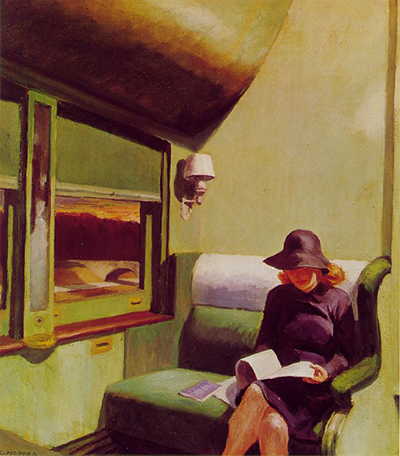Edward Hopper was born, in New York, July 22, 1882. He was a realist painter and printmaker, particularly well known for his oil paintings. He rarely discussed his art or himself, preferring to let his work speak for itself. He died on May 15, 1967.
“Compartment Car” is an oil painting, on canvas, created in 1938. This was a prolific period for the artist, during which many of his most important works were painted. In particular, “First Branch of the White River” and “New York Movie.”
The painting portrays a woman, sitting in the carriage of a train. Dressed all in blue, including her hat, she sits, reading a magazine. The compartment is painted green and is illuminated by a single lamp.
The window offers a glimpse of the outside. It appears to be evening, with the sky reddened by the setting sun. By his use of light and shade, Hopper makes the carriage appear warm and comfortable, while outside looks slightly sinister.
Hopper does not offer any story to this painting. He simply depicts a scene and leaves the viewer to imagine what is happening. Is the woman escaping from something? Maybe, she is travelling to meet someone? It certainly appears that she is travelling alone; with papers tossed on the seat beside her, she does not appear to have a companion.
The lone traveller is a common theme in Hopper’s art, with the subjects often pictured in hotel rooms, roadside diners or gas stations. A feeling of loneliness and melancholy is prevalent throughout much of his work.
The solitary female is also a common theme, as is the case in “Compartment Car”. Further examples can be found in his works “Intermission” and “Automat.”
This painting typifies Hopper’s work, displaying a scene to the viewer, and allowing them to create their own story around it. It is great fun to imagine where, and why, the woman in the carriage is travelling, even though we will never know the true answer.




